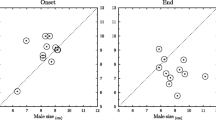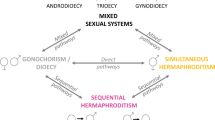Summary
We assessed the influence of phenotypic plasticity in age at maturity on the maintenance of alternative mating strategies in male Atlantic salmon,Salmo salar. We calculated the fitness,r, associated with the parr and the anadromous strategies, using age-specific survival data from the field and strategy-specific fertilization data from the laboratory. The fitness of each strategy depended largely on mate competition (numbers of parr per female, i.e. parr frequency) and on age at maturity. Fitness declined with increasing numbers of parr per female with equilibrium frequencies (at which the fitnesses of each strategy are equal) being within the range observed in the wild. Equilibrium parr frequencies declined with decreasing growth rate and increasing age at maturity. Within populations, the existence of multiple age-specific sets of fitness functions suggests that the fitnesses of alternative strategies are best represented as multidimensional surfaces. The points of intersection of these surfaces, whose boundaries encompass natural variation in age at maturity and mate competition, define an evolutionarily stable continuum (ESC) of strategy frequencies along which the fitnesses associated with each strategy are equal. We propose a simple model that incorporates polygenic thresholds of a largely environmentally-controlled trait (age at maturity) to provide a mechanism by which an ESC can be maintained within a population. An indirect test provides support for the prediction that growth-rate thresholds for parr maturation exist and are maintained by stabilizing selection. Evolutionarily stable continua, maintained by negative frequency-dependent selection on threshold traits, provide a theoretical basis for understanding how alternative life histories can evolve in variable environments.
Similar content being viewed by others
References
Alm, G. (1959) Connection between maturity, size, and age in fishes.Rep. Inst. Freshwater Res., Drottningholm 40 1–145.
Ash, E.G.M. and O'Connell, M.F. (1987) Atlantic salmon fishery in Newfoundland and Labrador, commercial and recreational, 1985.Can. Data Rep. Fish. Aquat. Sci. No. 672 284.
Berglund, I., Schmitz, M. and Lundqvist, H. (1992) Seawater adaptability in Baltic salmon (Salmo salar): a bimodal smoltification pattern in previously mature males.Can. J. Fish. Aquat. Sci. 49 1097–106.
Bley, P.W. and Moring, J.R. (1988) Freshwater and ocean survival of Atlantic salmon and steelhead: a synopsis.US Fish Wildl. Serv. Biol. Rep. 91, 88–109.
Bohlin, T., Dellefors, C. and Faremo, U. (1990) Large or small at maturity — theories on the choice of alternative male strategies in anadromous salmonids.Ann. Zool. Fenn. 27 139–47.
Bradshaw, A.D. (1965) Evolutionary significance of phenotypic plasticity in plants.Adv. Genet. 13 115–55.
Falconer, D.S. (1989)Introduction to Quantitative Genetics. Longman, London.
Field-Dodgson, M.J. (1988) Size characteristics and diet of emergent chinook salmon in a small, stable, New Zealand stream.J. Fish Biol. 32 27–40.
Gavrilets, S. and Scheiner, S.M. (1993) The genetics of phenotypic plasticity. V. Evolution of reaction norm shape.J. Evol. Biol. 6 31–48.
Gibson, R.J., Porter, T.R. and Hillier, K.G. (1987) Juvenile salmonid production in the Highlands River, St. George's Bay, Newfoundland.Can. Tech. Rep. Fish. Aquat. Sci. No. 1538.
Gross, M.R. (1985) Disruptive selection for alternative life histories in salmon.Nature 313 47–8.
Gross, M.R. (1991a) Evolution of alternative strategies: frequency-dependent sexual selection in male bluegill sunfish.Phil. Trans. R. Soc. Lond. B 332 59–66.
Gross, M.R. (1991b) Salmon breeding behavior and life history evolution in changing environments.Ecology 72 1180–6.
Hazel, W.N., Smock, R. and Johnson, M.D. (1990) A polygenic model for the evolution and maintenance of conditional strategies.Proc. R. Soc. Lond. B 242 181–7.
Houston, A.I. and McNamara, J.M. (1992) Phenotypic plasticity as a state-dependent life-history decision.Evol. Ecol. 6 243–53.
Hutchings, J.A. (1985) The adaptive significance of lakeward migrations by juvenile Atlantic salmon,Salmo salar Linnaeus. MSc dissertation Memorial University of Newfoundland, St John's, Canada.
Hutchings, J.A. (1993a) Adaptive life histories effected by age-specific survival and growth rate.Ecology 74 673–84.
Hutchings, J.A. (1993b) Reaction norms for reproductive traits in brook trout and their influence on life history evolution effected by size-selective harvesting. InThe exploitation of evolving resources (T.K. Stokes, J.M. McGlade and R. Law, eds), pp. 107–125, Springer-Verlag, Berlin.
Hutchings, J.A. and Morris, D.W. (1985) The influence of phylogeny, size and behaviour on patterns of covariation in salmonid life histories.Oikos 45 118–24.
Hutchings, J.A. and Myers, R.A. (1986) The economics of artificial selection for reducing the proportion of mature male parr in natural populations of Atlantic salmon,Salmo salar. Int. Counc. Explor. Sea CM Mini-Symposium,3, 25 pps.
Hutchings, J.A. and Myers, R.A. (1988) Mating success of alternative maturation phenotypes in male Atlantic salmon,Salmo salar.Oecologia 75 169–74.
Jones, J.W. (1959)The Salmon. Collins, London.
Jordan, W.C. and Youngson, A.F. (1992) The use of genetic marking to assess the reproductive success of mature male Atlantic salmon parr (Salmo salar, L.) under natural spawning conditions.J. Fish Biol. 41 613–18.
Kawecki, T.J. and Stearns, S.C. (1993) The evolution of life histories in spatially heterogeneous environments: optimal reaction norms revisited.Evol. Ecol. 7 155–74.
Leonardsson, K. and Lundberg, P. (1986) The choice of reproductive tactics as a mixed evolutionarily stable strategy: the case of male Atlantic salmon (Salmo salar L.).Rep. Inst. Freshwater Res., Drottningholm 63 69–76.
Levins, R. (1968)Evolution in Changing Environments. Princeton University Press, Princeton, NJ.
Maynard Smith, J. (1982)Evolution and the Theory of Games. Cambridge University Press, Cambridge.
Metcalfe, N.B., Wright, P.J. and Thorpe, J.E. (1992) Relationships between social status, otolith size at first feeding and subsequent growth in Atlantic salmon (Salmo salar).J. Anim. Ecol. 61 585–9.
Murray, A.R. (1968) Smolt survival and adult utilization of Little Codroy River, Newfoundland, Atlantic salmon.J. Fish. Res. Board Can. 25 2165–218.
Myers, R.A. (1984) Demographic consequences of precocious maturation of Atlantic salmon (Salmo salar).Can. J. Fish. Aquat. Sci. 41 1349–53.
Myers, R.A. (1986) Game theory and the evolution of Atlantic salmon (Salmo salar) age at maturation.Can. Spec. Publ. Fish. Aquat. Sci. 89 53–61.
Myers, R.A. and Hutchings, J.A. (1986) Selection against parr maturation in Atlantic salmon.Aquaculture 53 313–20
Myers, R.A. and Hutchings, J.A. (1987) Mating of anadromous Atlantic salmon,Salmo salar, with mature male parr.J. Fish Biol. 32 143–6.
Myers, R.A., Hutchings, J.A. and Gibson, R.J. (1986) Variation in male parr maturation within and among populations of Atlantic salmon,Salmo salar.Can. J. Fish. Aquat. Sci. 43 1242–8.
Naevdal, G., Holm, M., Moller, D. and Osthus, O.D. (1976) Variation in growth rate and age at sexual maturity in Atlantic salmon.Int. Counc. Explor. Sea CM E: 40.
Needham, A.E. (1964)The Growth Process in Animals. Pitman, London.
Northcote, T.G. (1984) Mechanisms of fish migration in rivers. InMechanisms of migration in fishes (J.D. McCleave, G.P. Arnold, J.J. Dodson and W.H. Neill, eds), pp. 317–55. Plenum Press, New York.
Parker, G.A. (1984) Evolutionarily stable strategies. InBehavioural ecology: an evolutionary approach (J.R. Krebs, and N.B. Davies, eds), pp. 30–61. Blackwell, Sunderland, MA.
Partridge, L. (1988) The rare-male effect: what is its evolutionary significance?Phil. Trans. R. Soc. Lond. B 319 525–39.
Power, G. (1980) The brook charr,Salvelinus fontinalis. InCharrs: salmonid fishes of the genus Salvelinus (E.K. Balon, ed.), pp. 141–203. Dr W. Junk, The Hague, Netherlands.
Ricker, W.E. (1975) Computation and interpretation of biological statistics of fish populations.Fish. Res. Board Can. Bull. 191
Schaffer, W.M. (1974) Selection for optimal life histories: the effects of age structure.Ecology 55 291–303.
Schmalhausen, I.I. (1949)Factors of Evolution. Blakiston, Philadelphia.
Slatkin, M. (1978) On the equilibration of fitnesses by natural selection.Am. Nat. 112 845–59.
Snucins, E.J., Curry, R.A. and Gunn, J.M. (1992) Brook trout (Salvelinus fontinalis) embryo habitat and timing of alevin emergence in a lake and a stream.Can. J. Zool. 70 423–7.
Stearns, S.C. and Koella, J. (1986) The evolution of phenotypic plasticity in life-history traits: predictions for norms of reaction for age- and size-at-maturity.Evolution 40, 893–913.
Thorpe, J.E. (1986) Age at first maturity in Atlantic salmon,Salmo salar: freshwater period influences and conflicts with smolting.Can. Spec. Pub. Fish. Aquat. Sci. 89 7–14.
Thorpe, J.E., Morgan, R.I.G., Talbot, C. and Miles, M.S. (1983) Inheritance of developmental rates in Atlantic salmon,Salmo salar L.Aquaculture 33 119–28.
van den Berghe, E.P. and Gross, M.R. (1989) Natural selection resulting from female breeding competition in a Pacific salmon (coho:Oncorhynchus kisutch).Evolution 43 125–40.
Via, S. and Lande, R. (1985) Genotype-environment interaction and the evolution of phenotypic plasticity.Evolution 39, 505–22.
Author information
Authors and Affiliations
Rights and permissions
About this article
Cite this article
Hutchings, J.A., Myers, R.A. The evolution of alternative mating strategies in variable environments. Evol Ecol 8, 256–268 (1994). https://doi.org/10.1007/BF01238277
Issue Date:
DOI: https://doi.org/10.1007/BF01238277




